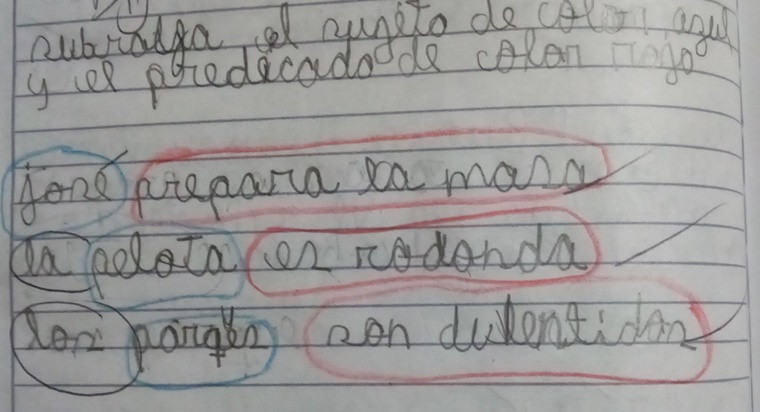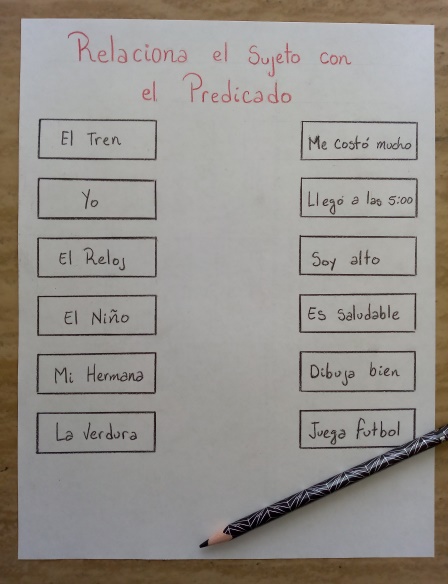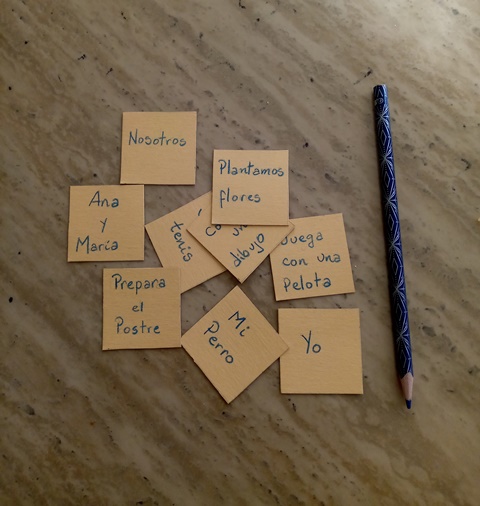Hello dear friends of @homeedders. Once our children already know how to read and write they must advance in the knowledge of the grammatical rules of their language, and understanding that every sentence is composed of the one who performs an action, the subject, and another part that expresses what is being done, the predicate, is fundamental to build their basis for grammar and writing skills. But introducing children to these abstract concepts through didactic activities can help them understand the basis for these concepts.
Hola queridos amigos de @homeedders. Una vez que nuestros niños ya saben leer y escribir deben ir avanzando en el conocimiento de las reglas gramaticales de su idioma, y comprender que toda oración está compuesta de quien realiza una acción, el sujeto, y de otra parte que expresa lo que se está haciendo, el predicado, es fundamental para construir sus bases para las habilidades en gramática y escritura. Pero presentar estos conceptos abstractos a los niños mediante actividades didácticas puede ayudarlos a comprender la base de estos conceptos.
That is why in this opportunity I want to share with you some strategies to learn about the subject and the predicate.
Es por eso que en esta oportunidad quiero compartir con ustedes algunas estrategias para aprender sobre el sujeto y el predicado.

Source: @emiliomoron, contains a public domain image.
We have already mentioned that when we have a sentence, we should be able to divide it into two component parts, the subject and the predicate. But how can we help children to distinguish them? Let's help them with these strategies.
Ya hemos mencionado que cuando tenemos una oración, debemos ser capaces de dividirla en dos partes que la componen, el sujeto y el predicado. Pero, ¿cómo podemos ayudar a los niños a distinguirlos? Vamos a ayudarlos con estas estrategias.
Clues / Pistas
Let's start by giving you some fundamental clues, first, who can be the subject? Let's explain that in a sentence, the subject can be a person, animal or thing.
Vamos a empezar por darles algunas pistas que son fundamentales, primero ¿quién puede ser el sujeto? Vamos a explicarles que en una oración, el sujeto puede ser una persona, animal o cosa.
Then we can make some examples in which it is easy to identify them, placing some sentences and asking them to identify the subject in each one.
Luego podemos realizar algunos ejemplos en los cuales sea fácil identificarlos, colocando algunas oraciones y pidiéndoles identificar el sujeto en cada una.

Source: @emiliomoron.
If they have doubts, we can tell you that you can ask yourself questions such as the following:
- Who made the food?
- What is round?
- What is funny?
These types of questions will help them find the subject in the sentence.
Si tienen dudas podemos decirles que pueden hacerse preguntas como las siguientes:
- ¿Quién hizo la comida?
- ¿Qué es redondo?
- ¿Qué es divertido?
Este tipo de interrogantes les ayudaran a dar con el sujeto en la oración.
Teaching materials / Material didáctico
- Match the subject with the predicate / Relaciona el sujeto con el predicado
This is a simple activity, for this we are going to give the children a sheet with some subjects and predicates distributed in two columns.
Esta es una sencilla actividad, para ello vamos a darles a los niños una hoja con algunos sujetos y predicados distribuidos en dos columnas.

Source: @emiliomoron.
And the activity consists of matching each subject located in one column, with the predicate that best corresponds, among those located in the other column.
Y la actividad consiste en emparejar cada sujeto ubicado en una columna, con el predicado que mejor corresponda, entre los ubicados en la otra columna.
- Order by group / Ordenar por grupo
For this activity we have made several cards containing different subjects and actions.
Para esta actividad hemos elaborado varias fichas que contienen diferentes sujetos y acciones.

Source: @emiliomoron.
And the dynamic is to drag each element to its correct group on a board that we have prepared for that.
Y la dinámica es arrastrar cada elemento hasta su grupo correcto sobre un tablero que hemos elaborado para eso.

Source: @emiliomoron.
- Complete with the predicate / Completa con el predicado
This activity was more of a game, we wrote some subjects on paper cards, such as "the house", "my dog", "that car" and we did the same with simple predicates such as "runs", "barks" "is big" , and on a sheet placed on the wall we made two columns and identified one with subjects and the other with predicate.
Esta actividad fue más bien un juego, escribimos algunos sujetos en fichas de papel, como “la casa”, “mi perro”, “ese carro” e hicimos lo mismo con predicados simples como “corre”, “ladra” “es grande”, y sobre una lámina colocada en la pared hicimos dos columnas e identificamos una con sujetos y otra con predicado.

Source: @emiliomoron.
For the dynamic I held the cards with the subjects and my son the cards with predicates, and the idea was that I would place a subject on the sheet and he had to place the predicate that would complete a sentence.
Para la dinámica yo sostuve las fichas con los sujetos y mi hijo las fichas con predicados, y la idea era que yo colocaría un sujeto en la lámina y él debía colocar el predicado que completara una oración.

Source: @emiliomoron.
At the end of the round we analyze each sentence, and of course we laugh a lot with the sentences that did not agree or the interpretation that he gave them haha, but with this practice the objective is that they remember the parts in which a sentence is divided and the meaning of subject and predicate.
Al final de la ronda analizamos cada oración, y por supuesto nos reímos mucho con las oraciones que no concordaban o la interpretación que él les daba jaja, pero con esta práctica el objetivo es que recuerden las partes en que se divide una oración y el significado de sujeto y predicado.
Nice job, I am also going to apply this strategy to my son once he reaches the right age. Greetings from the Philippines!
Hello friend, thank you very much, I'm glad you liked the strategies and they are useful, greetings!
You're welcome (^_^)
Es unA estrategia muy dinámica y creativa amigo, me encantó esta dinámica que realizó junto a su hijo. Saludos
Hola @emmaris, gracias por tu comentario, me alegra que te gustara la estrategia. Saludos!
Bendiciones @emiliomoron!! Muy divertida la manera de enseñar a tu pequeño partes de la oración. Es importante que los niños reconozcan de quien se habla en la oración y lo que se dice del sujeto.
Feliz día.
Saludos estimado @virgilio07, resultó muy entretenida, ciertamente es un conocimiento importante, y los juegos les ayudan a asimilar mejor los conceptos.
What a fun, simple way we can use at home with our little ones. I also love it because you can mix the cards and make new sentences as they progress in learning. Congratulations on an excellent explanation.
Me traslado a mi época de escuela y además a mis clases recibidas en la universidad de morfosintaxis del lenguaje, las cuales disfrutaba mucho. ¡Excelente estrategia! Saludos